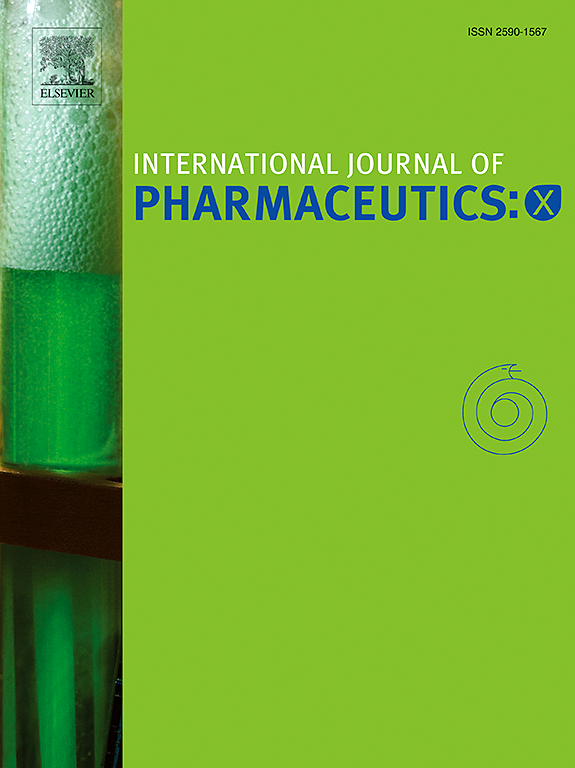An aptamer-conjugated mesoporous polydopamine formulation for synergistic targeted and photothermal therapy of hepatocellular carcinoma
IF 6.4
2区 医学
Q1 PHARMACOLOGY & PHARMACY
引用次数: 0
Abstract
This study aimed to create multifunctional nanoparticles (NPs), specifically [email protected] (AMLC), for the purpose of developing effective strategies for treating hepatocellular carcinoma (HCC) through targeted therapy and photothermal therapy (PTT). The study involved synthesizing mesoporous polydopamine (MPDA)-NPs, loading lenvatinib (Len) and Cy5.5 via incubation, and modifying AS1411 aptamer onto MPDA via a covalent chemical reaction. The NPs were characterized using techniques such as ultra-micro spectrophotometry, Fourier transform infrared spectroscopy, and transmission electron microscopy. Target-specific uptake and cell-killing assays were utilized to evaluate AMLC-mediated synergistic therapy while using Western blotting and immunofluorescence to confirm the underlying mechanism. Consequently, the nanoparticles (NPs) were successfully synthesized, demonstrating excellent solvent solubility and stability, with controlled drug release achieved in acidic environments (maximum release efficiency≈80 %). In vitro and in vivo studies revealed that these NPs could more effectively target hepatocellular carcinoma (HCC) cells, enhancing the targeting capability of lenvatinib. Under near-infrared (NIR) laser irradiation, the targeted photothermal therapy (PTT) exhibited significantly improved anticancer efficacy, with AMCL+PTT treatment resulting in up to 76 % tumor volume reduction (P < 0.01). The study demonstrates that AMLC, a multifunctional nano-delivery system, significantly enhances Lenvatinib's tumor-targeting capacity while exhibiting excellent biocompatibility. Combined with photothermal therapy (PTT), it demonstrates potent antitumor efficacy, showing promising clinical translation potential for hepatocellular carcinoma (HCC) therapy.
一种用于肝细胞癌靶向和光热协同治疗的适配体共轭介孔聚多巴胺制剂
本研究旨在创造多功能纳米颗粒(NPs),特别是[email protected] (AMLC),目的是通过靶向治疗和光热治疗(PTT)开发治疗肝细胞癌(HCC)的有效策略。该研究包括合成介孔聚多巴胺(MPDA)-NPs,通过孵育加载lenvatinib (Len)和Cy5.5,并通过共价化学反应将AS1411适体修饰到MPDA上。利用超显微分光光度法、傅里叶变换红外光谱法和透射电镜等技术对NPs进行了表征。利用靶向特异性摄取和细胞杀伤试验来评估amlc介导的协同治疗,同时使用Western blotting和免疫荧光来确认潜在的机制。因此,纳米颗粒(NPs)被成功合成,表现出优异的溶剂溶解度和稳定性,在酸性环境中实现了药物的可控释放(最大释放效率≈80%)。体外和体内研究表明,这些NPs可以更有效地靶向肝细胞癌(HCC)细胞,增强lenvatinib的靶向能力。在近红外(NIR)激光照射下,靶向光热疗法(PTT)显示出显著提高的抗癌效果,AMCL+PTT治疗可使肿瘤体积缩小高达76% [P <;0.01)。研究表明,多功能纳米递送系统AMLC能够显著增强Lenvatinib的肿瘤靶向能力,同时具有良好的生物相容性。结合光热疗法(PTT),显示出强大的抗肿瘤疗效,在肝细胞癌(HCC)治疗中显示出良好的临床转化潜力。
本文章由计算机程序翻译,如有差异,请以英文原文为准。
求助全文
约1分钟内获得全文
求助全文
来源期刊

International Journal of Pharmaceutics: X
Pharmacology, Toxicology and Pharmaceutics-Pharmaceutical Science
CiteScore
6.60
自引率
0.00%
发文量
32
审稿时长
24 days
期刊介绍:
International Journal of Pharmaceutics: X offers authors with high-quality research who want to publish in a gold open access journal the opportunity to make their work immediately, permanently, and freely accessible.
International Journal of Pharmaceutics: X authors will pay an article publishing charge (APC), have a choice of license options, and retain copyright. Please check the APC here. The journal is indexed in SCOPUS, PUBMED, PMC and DOAJ.
The International Journal of Pharmaceutics is the second most cited journal in the "Pharmacy & Pharmacology" category out of 358 journals, being the true home for pharmaceutical scientists concerned with the physical, chemical and biological properties of devices and delivery systems for drugs, vaccines and biologicals, including their design, manufacture and evaluation. This includes evaluation of the properties of drugs, excipients such as surfactants and polymers and novel materials. The journal has special sections on pharmaceutical nanotechnology and personalized medicines, and publishes research papers, reviews, commentaries and letters to the editor as well as special issues.
 求助内容:
求助内容: 应助结果提醒方式:
应助结果提醒方式:


